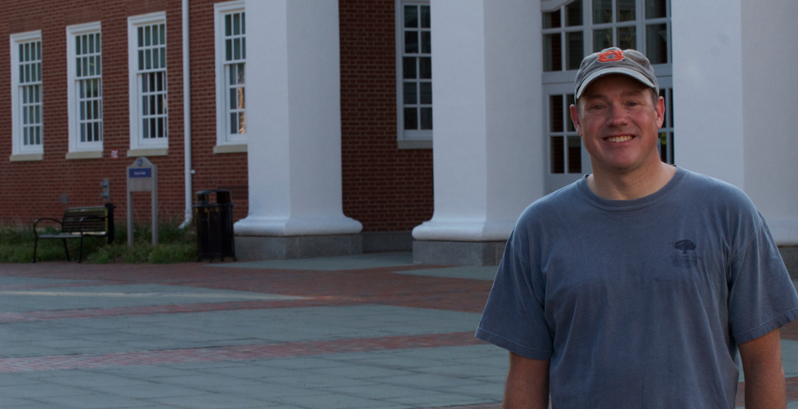COSAM News Articles 2020 September COSAM alumnus met Nobel laureates, develops coursework for students and continues to learn from others to become a better scientist
COSAM alumnus met Nobel laureates, develops coursework for students and continues to learn from others to become a better scientist
Chris Compton ’99, ’01 graduated with undergraduate degrees in both geology and physics from Auburn University. He currently works as a lab technician at Washington and Lee University, a small liberal arts college in Lexington, Virginia.
As a graduate student at West Virginia University, he was one of only 500 researchers given the opportunity to meet with Nobel laureates in Germany.
“I was a part of the Department of Energy’s delegation of students to attend the meeting,” Compton explained. “We spent a week attending lectures by physicists from around the world who had made groundbreaking discoveries. The highlights for me were having dinner with Arno Penzias, who won the prize for discovering cosmic background radiation and attending a lecture by Masatoshi Koshiba who had won the Nobel Prize just two years earlier for the detection of cosmic neutrinos. I had seen photos and read about Penzias and cosmic background radiation in textbooks for years, so sitting across from him at a table was surreal.”
At Washington and Lee University, he utilizes his skills to make an impact in the classroom.
“The priority is providing a positive and engaging classroom experience,” Compton said. “I spend the bulk of my time coordinating with introductory physics instructors developing lab exercises and in-class demos for those students. In other classes, I get to work with students designing projects for a wide array of physics and engineering courses. I also work with the research groups within the Physics and Engineering Department helping students learn to do research and hopefully, passing down some of what I gained from working with past advisors.”
While in the College of Sciences and Mathematics (COSAM), he worked with Ed Thomas, Jr. and still continues to engage in plasma physics research.
“Working with Ed in the plasma sciences lab was a great learning experience and a lot of fun too. My career would be drastically different had I not had the opportunity to work with him. He taught me how to take what I was learning in the classroom and apply it in the lab. At the time, we rebuilt the Auburn Linear EXperiment for Instablity Studies (ALEXIS), a device that is still in use at Auburn. This gave me a strong understanding of experiment design and has been an important building block throughout my career. Ed also set up a summer research experience through his collaboration with the Space Plasma Simulation group at the U.S. Naval Research Laboratory which directly led to a job with that group after finishing my master’s degree,” he shared.
His area of research is research is space plasma phenomena and plasma diagnostics.
“Plasma physics is a fascinating area to study,” Compton explained. “We regularly see man-made plasma in the form of fluorescent or neon lights and more recently televisions. We see naturally occurring plasma as lightning, the aurora, and the sun. I’m particularly interested in the plasma that we find surrounding the Earth. I first learned of its effects in high school, studying how radio waves can bounce off the ionosphere and propagate much farther distances than line of sight would allow. Depending on the properties of the surrounding plasma, waves can propagate or be suppressed. To understand these properties and what wave behavior can be expected, we need appropriate diagnostics.”
In his research he uses a variety of tools to measure the properties of plasma.
“We are interested in things like density, temperature, or flow of plasma. We also want to look at the instabilities in the plasma, so a simple antenna to pick up electromagnetic waves or diagnostics that can measure magnetic field oscillations can be useful. Using these diagnostics in a lab based plasma that has the same relative conditions you would find in space allows us to test theoretical models of observations made in space based experiments. In turn, we can use our knowledge from lab diagnostics to improve measurements made on board sounding rockets and satellites,” he said.
Compton was always interested in science.
“My earliest memory of anything science related is watching Mr. Wizard on television, and trying his experiments at home,” he added. “Science was always my favorite subject in school, especially the Earth and space science portions. I knew I wanted to do something that would allow me to explore that in-depth. I briefly thought I wanted to study engineering, but found my way back to the sciences during my freshman year at Auburn.”
He continues to be a lifelong learner.
“The most important thing I’ve learned is to take every opportunity to learn from those around you. I have been able to pick up new things from my colleagues in all disciplines that continue to make me a better scientist,” Compton said.
Latest Headlines
-
07/09/2024
-
Summer Bridge Program celebrates 21 incoming Auburn students as they prepare for future STEM careers07/02/2024
-
07/02/2024
-
06/17/2024
-
06/07/2024

